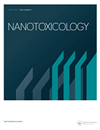
該雜志邀請有關納米結構材料與生物之間相互作用研究的貢獻。這種相互作用被稱為“干濕界面”。雖然以分子形式呈現給生物體的物質的毒理學特性受到經典毒理學的支持,但在存在毒理學機制(主要由表面化學決定)的情況下,似乎存在分子或原子聚集的大小范圍。正是這個大小范圍定義了這個日志的范圍。盡管該雜志的大部分活動將涉及對與納米尺度材料的生物相互作用的研究,但其范圍不應就此結束,而應擴大到包括所有人造納米結構材料,例如,包括活組織與假體表面之間的相互作用(例如,磨損能生產納米顆粒)或“生態納米毒理學”(即納米材料在生物圈中的運動、與細菌、無脊椎動物和脊椎動物的相互作用)。本雜志范圍內相互作用的性質包括納米結構材料及其分解產物在人類、實驗動物、環境和生物群中的流動性、持久性和毒性。通過使用活體外和活體內風險評估方法來評估和測量這種相互作用的技術發展是本雜志感興趣的一個主要領域。這些包括在生物系統中納米顆粒通過膜的傳輸機制。在顆粒毒性領域,雜志希望鼓勵提交論文的具體領域包括:與粒徑減小相關的毒性機制。這些研究包括有助于理解與基本生理機制的潛在相互作用,如離子轉運、K通道和鈣攝取。同樣具有相關性的還有顆粒的催化表面性質與其毒性的相關性、納米顆粒作為佐劑的重要性及其在免疫毒性中的相關性以及納米結構表面自由基生成的重要性。該雜志特別關注通過涂層和其他方法將毒性降至最低的方法,例如納米顆粒在治療疾病中的醫學和治療用途。該雜志在其范圍內,通過職業和人群研究以及對照臨床研究的流行病學論文,包括納米結構材料的危害證據。
The journal invites contributions addressing research into the interactions between nano-structured materials and living matter. This interaction has been dubbed the 'wet dry interface'. While the toxicological properties of substances presenting to organisms as molecules comes under aegis of classical toxicology, there appears to be size range of aggregations of molecules or atoms where there are toxicological mechanisms which are determined predominantly by surface chemistry. It is precisely that size range which defines the scope of this journal. Although much of the activity of the journal will involve investigations of the biological interactions with nano-scale materials, its scope should not be seen to end there but to extend to include all man-made nano-structured materials, for example including the interactions between living tissues and the surfaces of prostheses (e.g. wearing can produce nanoparticles) or in the context of 'eco-nanotoxicology' (i.e. the movement of nanomaterials through the biosphere, interactions with bacteria, invertebrates and vertebrates). The nature of the interactions within the scope of the journal includes the mobility, persistence and toxicity of nano-structured materials and their breakdown products in humans, experimental animals, the environment and within biota. Developments in technique for assessing and measuring such interactions through the use of in vitro and in vivo methods for risk assessments are a major area of interest for the journal. These include mechanisms of transport of nano-particles across membranes in living systems. Specific areas in the field of particle toxicity in which the journal wishes to encourage submission of papers include: the mechanism of toxicity associated with diminishing particle size. These include investigations leading to understanding of potential interactions with basic physiological mechanisms such as ion-transport, K-channels and Ca uptake. Also of relevance are the relevance of catalytic surface properties of particles to their toxicity, the importance of nano-particles as adjuvants and their relevance in immuno-toxicity and the significance of free radical generation at nano-structured surfaces. The journal is particularly interested in methods of toxicity minimisation, through coatings and other methods, in fields such as the medical and therapeutic use of nano-particles in the treatment of disease. The journal includes within its scope evidence of harm from nano-structured materials through epidemiological papers from occupational and population studies as well as controlled clinical studies
SCI熱門推薦期刊 >
SCI常見問題 >
職稱論文常見問題 >
EI常見問題 >